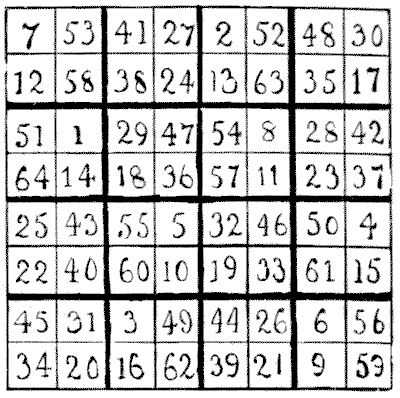(related to Problem: Magic Squares Of Two Degrees)
The following is the square that I constructed. As it stands the constant is $260.$ If for every number you substitute, in its allotted place, its square, then the constant will be $11,180.$ Readers can write out for themselves the second degree square.

The main key to the solution is the pretty law that if eight numbers sum to $260$ and their squares to $11,180,$ then the same will happen in the case of the eight numbers that are complementary to $65.$ Thus $$1 + 18 + 23 + 26 + 31 + 48 + 56 + 57 = 260,$$ and the sum of their squares is $11,180.$ Therefore $$64 + 47 + 42 + 39 + 34 + 17 + 9+ 8$$ (obtained by subtracting each of the above numbers from $65$) will sum to $260$ and their squares to $11,180.$ Note that in every one of the sixteen smaller squares the two diagonals sum to $65.$ There are four columns and four rows with their complementary columns and rows. Let us pick out the numbers found in the $2$nd, $1$st, $4$th, and $3$rd rows and arrange them thus :— $$\begin{array}{cccccccc} 1&8&28&29&42&47&51&54\\ 2&7&27&30&41&48&52&53\\ 3&6&26&31&44&45&49&56\\ 4&5&25&32&43&46&50&55\\ \end{array}$$
Here each column contains four consecutive numbers cyclically arranged, four running in one direction and four in the other. The numbers in the $2$nd, $5$th, $3$rd, and $8$th columns of the square may be similarly grouped. The great difficulty lies in discovering the conditions governing these groups of numbers, the pairing of the complementaries in the squares of four and the formation of the diagonals. But when a correct solution is shown, as above, it discloses all the more important keys to the mystery. I am inclined to think this square of two degrees the most elegant thing that exists in magics. I believe such a magic square cannot be constructed in the case of any order lower than $8.$
This eBook is for the use of anyone anywhere in the United States and most other parts of the world at no cost and with almost no restrictions whatsoever. You may copy it, give it away or re-use it under the terms of the Project Gutenberg License included with this edition or online at http://www.gutenberg.org. If you are not located in the United States, you'll have to check the laws of the country where you are located before using this ebook.